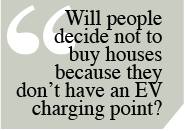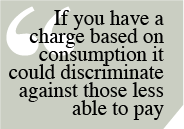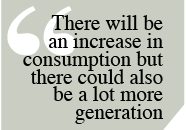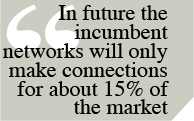First published in New Power Report, August 2017
In most new housing, utility connections are provided not by incumbent network companies but by independents. Their numbers have been growing. Vicki Spiers is the current chair of the industry bodies for those providing gas and electricity connections. She spoke to Janet Wood
 Currently about two million domestic customers receive their gas through connections owned and operated not by local monopoly gas distribution networks (GDNs) but by independent companies. In electricity, about half a million are served by independents. That number is growing fast, says Vicki Spiers, chair of the Association of Independent Gas Transporters (AIGT) and the Competitive Networks Association (CNA, which brings together the electricity networks).
Currently about two million domestic customers receive their gas through connections owned and operated not by local monopoly gas distribution networks (GDNs) but by independent companies. In electricity, about half a million are served by independents. That number is growing fast, says Vicki Spiers, chair of the Association of Independent Gas Transporters (AIGT) and the Competitive Networks Association (CNA, which brings together the electricity networks).
“In new housing developments, about 75% of new gas connections go to independent gas connectors. In electricity it’s gone more slowly but we think it will go in the same direction,” she says. Spiers thinks in future the incumbent networks will only make connections for about 15% of the market – where they have existing networks.
The independent networks have grown in the past decade alongside a competitive business in planning and installing “last mile” connections to domestic properties. The independents have been in gas networks since the first PGT (public gas transporter) licences were issued in 1996 and in the electricity side since about 2005. After consolidation in the industry between 2006 and 2012, it is growing again. Companies that install those services (gas, electricity, water, telecoms) have been winning business against the large networks and whereas initially they simply laid the infrastructure, which was then “adopted” by the incumbent network, some saw the opportunity of having a long-term business in continuing to own and operate the pipes and wires.
But Spiers says some companies have found “it’s not perhaps as easy as it seems [to get into the business]”. The hurdles, she explains, many be processes “like having to have a safety case”. But it is also “just the complexity of the industry”.
 “There are a lot of changes going on, so there are things, like the IT requirements for your meter point administration system, that don’t come cheap – and they have to be maintained. There are a lot of regulation changes, which means you have to be keeping up with all of that and making sure you are compliant.”
“There are a lot of changes going on, so there are things, like the IT requirements for your meter point administration system, that don’t come cheap – and they have to be maintained. There are a lot of regulation changes, which means you have to be keeping up with all of that and making sure you are compliant.”
Spiers adds: “We have been through quite a lot of pain in opening [the industry] up. There have been different levels of resistance and support from the larger players.
“There were two different routes. In the gas world it was pretty much ‘row your own boat’ which was why we ended up in an anomalous position where IGTs all had their own IT systems to interact with suppliers. That became problematic.” The advent of a new system, Project Nexus, has brought all the IGTs onto the same platform as the GDNs.
In contrast, says Spiers: “In the DNO [electricity] world they said on day one you will have to comply with all these systems and use them. It’s quite a financial barrier when you enter the market, because these things don’t come cheap, but there is absolutely no differentiation between DNO and IDNO customers in the way they are treated. I think suppliers from an electricity point of view probably see it as smoother and easier,” says Spiers.
The future for electricity
I am talking with Spiers soon after the Energy Networks Association publishes a formal definition of a distribution system operator for the first time, so I ask what the evolution of DNOs to DSOs means for the electricity independents.
She says: “Because by definition we are the last mile, we will be less involved in that very high-level high-voltage discussion.”
DNOs look like adopting less than a fifth of new developments in future and, she says: “That’s partly because we can offer asset value that the DNOs can’t. We offer a payment to adopt those networks and it’s a commercial arrangement between the DNO and contractor providing infrastructure for the housing developer, so we can enable them to install more cheaply and effectively. Plus we offer agility and a turnkey service – it’s a slightly more commercial approach.”
She suggests that large DNOs, “having been in the business a long time” are less able to deliver innovation. “The way new housing developments are going to look will change. There will be more generation behind the meter.
“But it’s beholden on both groups to look at how usage is going to change – not just generation but for things like electric vehicles.”
 The question is about change in the housing market, rather than the electricity industry. “Will people decide not to buy houses because they don’t have an electric vehicle charging point? That will make a difference and it will be driven by consumer behaviour. Keeping close to the way those trends are going is important for all of us.”
The question is about change in the housing market, rather than the electricity industry. “Will people decide not to buy houses because they don’t have an electric vehicle charging point? That will make a difference and it will be driven by consumer behaviour. Keeping close to the way those trends are going is important for all of us.”
It is housing developers who will drive the change, she says. “They bring networks to contractors and say, ‘this is what we want to do’.” In the end developers will want “whatever gets traction with home purchasers; we are very keen to look at that and provide whatever services we need to make sure the network capacity and capability is there”.
So far, “it’s not a huge movement”. “You have the Volvo announcement and that could be a real game changer. It’s a significant player that is going to start people thinking about it as they change their cars. But will they [change to an EV] if they don’t think they can get a connection and charge up?”
Are developers asking for home energy storage? She says it seldom arises at the moment, but in her view, “as soon as they can crack a home battery and use it with the electric cars, that has real game-changing implications”. And are housebuilders still installing renewables? She says: “It has peaked but there are still developments going on.”
Are there likely to be network constraints? “If there is huge demand and we haven’t built a network to support it, clearly there will be reinforcement costs. That’s not in our interests, so we are looking to make sure we understand what consumption might be. There will be an increase in consumption but there could also be a lot more generation, so overall it may not go up so much.
“In future the two-way data flows will allow us to manage that. That will come from access to greater data in terms of smart metering and bringing all that information back in. But how long it will take to get to that level of sophistication is not clear.”
 At the moment neither incumbents nor independent networks have much direct relationship with customers. Will that have to change? Spiers thinks “there will need to be a relationship with the customer, but whether it will be through the network companies [is not clear] – I think the supplier is more likely”. “Network operators need to understand their consumption patterns but I imagine that will be on a more macro level than individual consumers.”
At the moment neither incumbents nor independent networks have much direct relationship with customers. Will that have to change? Spiers thinks “there will need to be a relationship with the customer, but whether it will be through the network companies [is not clear] – I think the supplier is more likely”. “Network operators need to understand their consumption patterns but I imagine that will be on a more macro level than individual consumers.”
The wider question is how long our existing system of network charging will be fit for purpose. Currently it is on a per-kilowatt-hour basis and charged through the supplier. But other options like a capacity charge, or even an insurance-type charge, have proposed. Spiers says: “There are all sorts of different things being talked about. You could pay for capacity. As the network company you have to make that capacity available, but if you find that it’s not used it possibly can be re-distributed around the network. It may be a way of transferring the cost. But if you have some sophisticated purchasers who are doing a lot ‘behind the meter’ your whole structure still has to be paid for. If you continue to have a charge based on consumption it could discriminate against those less able to pay.
“That comes to the regulator and the network companies have difficult decisions to make about a direction that is fair across the whole of the consuming public.”
For the independents the methodology at the moment is to mirror the incumbent. Spiers says: “It’s slightly out of kilter because the DNO charges are set based on the allowed revenue and it’s the avoided cost that comes to the independents. It implies that we have exactly the same cost to build networks, which I don’t think is always the case. The regulator has to stimulate innovation and make sure it is an attractive enough proposition for investors… to make sure that we can build.”
 Reviews of the current and upcoming distribution price control and the common distribution charging methodology have started, and although it is early days in the discussion, Spiers says: “A number of the areas highlighted for further investigation have not been taken forward, which we have found disappointing and we would look to try to make that more transparent. The question is how we make this whole process a little bit easier for IDNOs. The cost of debt and equity differs for independents, so our concern would be if those considerations were not taken into account in the next price control. If they are squeezed it would affect all the independent operators. We don’t have the same cost of capital as the larger parties.
Reviews of the current and upcoming distribution price control and the common distribution charging methodology have started, and although it is early days in the discussion, Spiers says: “A number of the areas highlighted for further investigation have not been taken forward, which we have found disappointing and we would look to try to make that more transparent. The question is how we make this whole process a little bit easier for IDNOs. The cost of debt and equity differs for independents, so our concern would be if those considerations were not taken into account in the next price control. If they are squeezed it would affect all the independent operators. We don’t have the same cost of capital as the larger parties.
“What investors want is long-term certainty and that’s why they get into regulated industries. There’s a balance. We need to make sure we are innovative enough to meet the needs of the consumer, but we’re not going to meet anybody’s needs if no-one is investing. Ofgem has a pivotal role to play in making sure they are taking all sides of that question into account.”
The Future of gas
What’s the future for gas networks? Under long-term decarbonisation plans, both fossil gas and the networks that carry it would disappear entirely. But under most scenarios they are still in place in 2030 and the network is still being expanded.
Spiers says: “The UK has a real emotional attachment to gas. I don’t see it disappearing any time soon. The infrastructure is all there and it’s capable of distributing from whatever source to individual properties, so the idea that you would do something fundamentally different and have to replace all that is just cost prohibitive.”
She is referring to options like using waste-derived or other biogases, or converting parts of the network to transport hydrogen or heat. “There are questions about how you then manage the quality and how to charge appropriately for it, so there are issues to be resolved, but they are not insurmountable. The message from us is that we are looking at these things and we want to be part of that future. We don’t want to see this infrastructure disappear – partly from self-interest. But why as GB PLC would you want to replace something at huge cost if there are ways to do it that are cheaper?”
I suggest that as they install new networks, the independents could offer a route for trials. Is there an urge to innovate? Spiers says: “There isn’t, because we don’t currently get the incentive payments. But if that financial signal changed there is an opportunity because they are discrete networks and you could be more experimental and more innovative.
“I think we are a young forward-looking body of people and we would be keen to embrace that provided that the right investment was there. The independent networks are all relatively young, so they are made of modern materials, so it’s a good place to start trials. But at the moment it would be not exactly what investors had signed up for and it comes down to risk appetite.”
Industry funds like the Network Innovation Competition are available to the independents, unlike RIIO incentives. Spiers says: “The wider you make those incentives opportunities the wider the innovation can be rolled out.”
I ask whether we need a bigger public discussion about the future of the gas networks and she agrees that it’s needed to “start to get a sense of where the benefits are to be had, and the direction of travel”. “Until that discussion really gets under way we can’t do anything.”
Learning lessons from Project Nexus
Project Nexus was a long, complex IT project that brought all the parties in the gas industry on to the same software platform. It took many years longer than originally planned and finally went live earlier this year.
Vicki Spiers says: “Hopefully the industry has learned a lot from that in terms of how we will manage future projects, because there is a lot of change that is coming down the line.” She mentions faster switching, saying: “We are a few years away from that but the planning and preparation is happening now.”
What lessons would she take from Project Nexus? She says that when you are trying to get so many parties to collaborate, “you need one central body to have that oversight and that assurance piece”. When that happened, “that’s when things that really started to change with Nexus”. “It was difficult for [central body] Xoserve to be in charge when there were so many different partners involved. Xoserve had a view of its own IT change, but others all had their own systems. There was no-one with that oversight across the rest of the industry.” There should be a co-ordinator “even if it’s just to observe and to highlight where people are falling behind”.
I ask if that should be the regulator, and Spiers says: “It’s not really their role to manage projects.” She thinks industry should be looking to come together and make sure that there is that assurance. “There would need to be a procurement piece, to ask who is the right party to do the work, what experience they have that is relevant and to get that body in place.”
When I ask whether IT development should be driven centrally, by BEIS or Ofgem, she points out that although companies get around the table, “they are all competitors and they are trying to get one step ahead by having better, different or more efficient systems”. “That innovation shouldn’t be stymied by having a one size fits all.” BEIS and Ofgem, she says, “have a big job trying to make a regulatory framework that fits and allows for innovation without being too prescriptive about what you can and can’t do”. We need to see how that works, she adds. But in any case, “the next few years will see major innovation and new parties coming into the industry” and “it wouldn’t be right for either a government or the regulator say this is how you do it – I just don’t think they know any more than any of us how it will all evolve”.
Rolling out smarter meters
The independent networks are installing smart meters at all their new developments, says Spiers, “because otherwise you’re just storing up a legacy problem”. That means so-called Smets 1 meters, because “we think it’ll be the back end of this year before there is any real volume of Smets 2 going in”.
Spiers thinks delay in the 2020 deadline for the smart meter rollout is almost inevitable. “It’s a little bit emperor’s new clothes. Everyone thinks there will be a delay but nobody’s coming out and saying it yet.” She says that maintaining the deadline, “pushes people along, but… if it is in the end detrimental to the programme overall then it should be reconsidered and potentially pushed out. I think there was some softening about around the government’s ability to amend and change that deadline and that seemed like a clear signal.” She adds: “Three or four years ago we thought we would be much further down the road than we are. Suppliers have been using friendly customers in the early rollout and doing things in quite a controlled way.
“We anticipated an increasing number of requests for removal or change services to accommodate the rollout, but it has not materialised. We still expect it, because there will be scenarios where it is not fit for purpose or some other reason people will want to have access to the meter more frequently.”
The independents could have taken on some of the rollout contracts, but they were unsuccessful. “There were tenders that came out and we responded to them, but the big six in particular have gone to one or two larger suppliers or they have taken it in-house.” However, Spiers notes, “I think some of the smaller suppliers in particular haven’t made those decisions”.
Independents have to supply registration data for smart meters. Spiers thinks eventually the electricity independents will have to join the new central body, the DCC. “We’re keeping very close to it. I think certainly for IDNOs, as the volume of customers increases, having access to the information and being able to compile it in big data will become more valuable.”